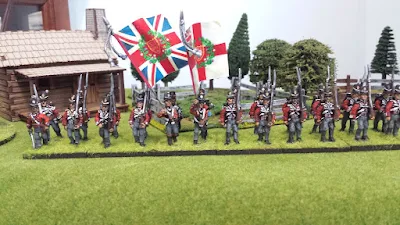A major question when creating your British/Canadian army for the War of 1812 is which shako type will your regulars wear? Opinions, debate and speculation about what equipment might have been in stores, Horse Guard's attitudes toward equipping units in far-flung quarters, and isolated and obscure eye-witness accounts all flavor the question. I still have not pinned down sources but here are my thoughts and opinions and I sincerely welcome you to draw your own conclusions.
.jpeg) |
| Stovepipe |
.jpeg) |
| Belgic |
A British infantryman's cap (shako) was meant to last him two years. If an infantryman was issued a stovepipe shako in 1812, it would not be replaced until 1814 unless the entire unit was re-equipped. The British army went to war against Napoleon in Spain wearing the Stove Pipe shako. The Belgic shako (sometimes called the "Waterloo" shako) was adopted by regulation in 1812, but did not find its way into the hands of infantrymen until nearly the end of fighting in Spain. It is usually associated with the Battle of Waterloo in 1815.
 |
| 1812/1813 |
What about the written orders in Canadian or British archives that determine which caps were in service. As it turns out, the orders provide very little guidance as the headgear is simply referred-to as "caps", or "felt caps."What the neck is a "Felt Regulation Cap." Is it a stovepipe or Belgic shako? Both were made of felt. Other documents mention 600 "bucket caps" returned to storage at Kingston in 1813. Were these stovepipe shakos returned because they had been replaced by Belgic shakos, or were they the shorter bucket shakos worn by Caldwell Rangers? One would think these clerks could be more helpful!!!!
 |
| 1814 |
The solution I have reached for my armies (and it is only an opinion) is that the Stove Pipe shall was worn in 1812/1813 and the Belgic shako by the time the 1814 Niagara campaign. There remains much debate about the Incorporated Militia regiment. The remainder of the militia, especially the Sedentary Militia, are presumed to be wearing primarily castoffs and items brought from home. This could let you field them in stovepipe shako, round hats or any civilian hat or cap you like.



I think your solution is a sensible one, in light of any other more conclusive evidence. Plus it's an easy visual way of distinguishing units that can be classed for differing levels of morale or training etc.
ReplyDeleteI am pretty much in agreement with you Mark - but as I already had a pile of Stovepipe wearing British infantry for the peninsula, when I did "new" units for the War of 1812, I did most of the British regulars in Belgic shakos, just to make them a little bit different!
ReplyDeleteYour solution seems the right one to me Mark, it's certainly the one I would go for.
ReplyDeleteThank you all very much. Appreciate your comments and hope this has been of service.
ReplyDeleteSounds like good logic to me, the only other 'house-rule' I could think of would be to limit the later, 'Belgic', shako to those units released by Napoleon's first downfall to be sent to the Americas. They would surely be refitted before being redeployed.
ReplyDeleteI'd agree with everyone else, it does seem the sensible option.
ReplyDelete